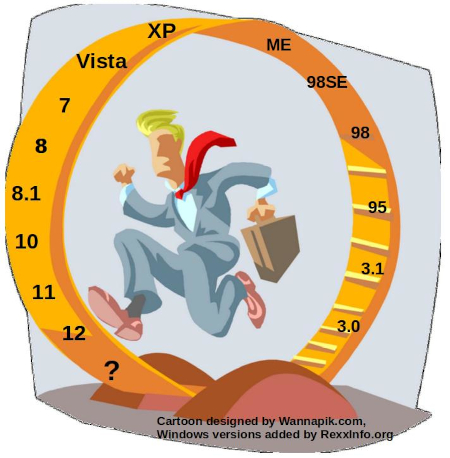Why You Shouldn't Refurbish With Windows
by Howard Fosdick RexxInfo.org
You've acquired a computer you'd like to refurbish. Perhaps you retrieved it from your basement or attic, or maybe you got it from a friend, a recycler, or the town dump. Should you clean up the existing Windows install? Do a Windows Reset? Install Windows anew?
With over a billion users worldwide, Windows is enormously popular. Somewhere around 70% of all laptops and desktops run Windows.
This dominance proves Windows' suitability for an incredibly wide range of situations and tasks.
However, one role Windows is not appropriate for is computer refurbishing. This article explains why, and tells what to do instead.
Here is why Windows is a poor choice for computer refurbishing ...
1. Planned Obsolescence
New Windows versions are designed for state-of-the-art equipment. They aren't back-ported to older hardware.
Thus Windows enforces planned obsolescence for computer hardware. The usual rule of thumb is that you can upgrade a windows computer from one version to the next, but not across two versions.
Take the upgrade from Windows 10 to Windows 11 as an example. The Windows 11 system requirements require Trusted Platform Module 2.0. Most computers that shipped with Windows 8.1 or before do not meet this requirement. They are cut off from upgrading to 11.
Meanwhile, Windows 10 loses support. (You can pay for security fixes for Win 10 through Microsoft's ESU program, but the cost doubles every year.)
Since Windows becomes vulnerable without security updates, this incentivizes customers to junk computers that won't run Win 11. Even if their hardware works just fine.
Now, as Win 11 entered the marketplace, clever hackers figured out ways to run it on computers that lack TPM 2.0. But that's beyond the ken of the typical user.
Here's proof: as a refurbisher, I witnessed a tidal wave of Win 8.x and 7 computers in good working order hit the recyclers and town dumps as a result of the Win 11 upgrade.
Every new Windows version causes this same cycle. From TPM, to Secure Boot, to the ever-evolving list of required processors and other hardware requirements, it's all designed to obsolete mature computers. I see a flood of perfectly good computers sent to trash every time Microsoft introduces a new Windows version.
If a goal of refurbishing is to keep mature hardware in use, Microsoft's versioning strategy directly works against this.
The artificially shortened lifespan for Windows hardware makes Windows a poor choice for reburbishing.

| Windows Version: | Released to Manufacturing: |
| Windows 12 | 2026? |
| Windows 11 | 2021 |
| Windows 10 | 2015 |
| Windows 8.1 | 2013 |
| Windows 8 | 2012 |
| Windows 7 | 2009 |
| Windows Vista | 2007 |
| Windows XP | 2001 |
| Windows ME | 2000 |
| Windows 98SE2 | 1999 |
| Windows 98 | 1998 |
| Windows 95 | 1995 |
| Windows 3.1 | 1992 |
| Windows 3.0 | 1990 |
2. Licensing Headaches and Activation
Windows versioning and licensing can be complicated. For example, say you want to transfer a boot disk from one computer to another. You better know about the differences between Retail, Volume, and OEM licenses.
Want to copy a Windows install to a flock of computers you're refurbishing? Unless you have a corporate license and the proper tools, you're out of luck.
An open source system like Linux allows you to move, copy, duplicate, or replicate an installed system however you like, as many times as you like. That includes all the installed apps.
Linux imposes no artificial restrictions due to licensing or activation. Its flexibility simplifies many refurbishing operations that Windows either complicates or forbids.
3. Cost
Refurbishing supplies low cost computer systems for those who can't afford new systems. This is important in the U.S., where some 23 million people remain offline in an age of mandatory internet access.
Windows requires license fees, and its apps impose additional costs. Linux and all its apps are free.
If the goal is to keep mature computers in service and get them to those who can't afford new systems, free software wins hands-down.
4. Malware
Windows is famously susceptible to viruses and malware. These threats dog inexperienced or naive users.
Linux is not immune to malware, but incidents are rare.

Why the difference? One factor is simply that Windows is more frequently targeted. It offers a much larger pool of potential victims. The lion hunts where the sheep congregate.
More subtly, Windows presents a much larger attack surface to miscreants. Researchers estimate that Windows 11 consists of between 60 and 100 million lines of code. Linux clocks in about 40 million lines.
Lastly, both expert and conventional wisdom opines that Linux's design is inherently more secure than Windows. (If you wish to explore this controversy for yourself, read these references.)
Given this disparity, nearly all Windows users run real-time anti-malware. Linux users rarely do.
This impacts the performance of mature, resource-limited computers. Windows anti-malware programs often consume an entire OS thread and cause extra disk access. Linux reserves this computing power for application programs.
5. Resource Use
The resources -- processors and memory -- required to run a computer depend on its operating system, applications, and the tasks the user performs.
Nevertheless, it's fair to state that Windows requires substantially more resources than does Linux.
This becomes critical if you're using an older computer.
I can refurbish a Linux PC with only 6 gigabytes of memory and any Intel i-Series processor, and it will work just fine for most users. The "low bar" for Linux rescues many computers that either won't run Windows smoothly or at all.
Conclusion
Windows is an excellent operating system for a very wide range of purposes.
However, refurbishing is not one of them. Windows' dictated lifespan, its cost, the additional hardware requirements it imposes with every new version, and the restrictions imposed by its licensing all argue for a more appropriate solution.
Open source Linux fits refurbishing requirements better. That's why the refurbishing articles on this website focus on Linux. It better fits the task.
Related Articles
Fixing / Refurbishing Computers --
The Ultimate Guide to Computer Refurbishing
How to Refurbish Old Single Core Computers
How to Get a Free Computer... Really!
Home Computing --
Why You Should Use Generic Computers and FOSS
How to Secure Your Home Wireless Network
How to Get 100% Availability for Your Home Office
Linux --
Linux Performance Tips
How to Upgrade Linux PC Hardware
How to Identify Linux Performance Bottlenecks
Reclaim Big Disk Space by File Conversions
How to Shrink PDF Files
How to Traverse Directories in Scripts
How to Use PUSHD and POPD
Bash to Python Mapping & Comparison
All About Scripting Languages
-----------------------------------
====> Like this article? Spread the link love to Slashdot, LXer, or your favorite social media. Thank you.